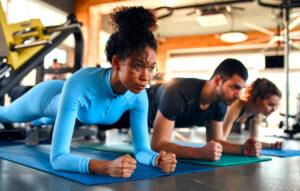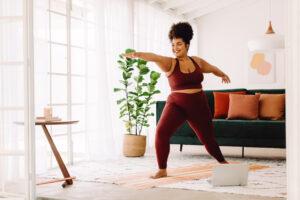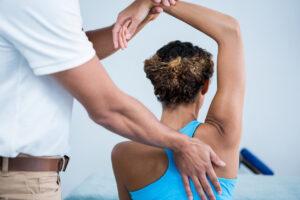As Fall is now in full swing, many are starting to get into routine and set up their exercise regimen. When it comes to the classic workout, there are two primary options: hitting the gym or exercising in the comfort of your own home. Both fitness approaches have their merits, but which one is more effective for you?
In this post, we’ll explore the advantages and disadvantages of the at home workout vs. gym workout and provide some expert recommendations for effective at-home exercises, from your , from your local Surrey physiotherapist’s perspective!
The Gym Advantage

- Access to Equipment: One of the most significant advantages of gym training is the availability of specialized equipment. A gym workout is equipped with various machines and free weights that allow for targeted muscle training and a wide range of exercise options. This is particularly beneficial if you’re looking to build muscle mass.
- Motivational Environment: For many individuals, the gym provides a motivating environment. Surrounded by like-minded people and fitness professionals, you may find it easier to stay on track and push yourself to reach your fitness goals. This atmosphere can be especially helpful for those who thrive on competition and camaraderie.
- Structured Workouts: Gyms often offer structured classes and programs led by certified trainers. These classes provide a systematic approach to fitness, ensuring that you engage in a well-rounded workout that targets various muscle groups. Additionally, personal training can provide guidance on proper form and technique to minimize the risk of injury.
The At-Home Advantage

- Convenience: One of the most appealing aspects of the home workout is convenience. You can exercise at any time that suits your schedule without the need to commute to a gym. This flexibility is ideal for those with busy lives, as it removes the barriers to consistent exercise.
- Cost-Effective: Gym memberships can be expensive, and many individuals find that a home workout is the ideal cost-effective alternative. You don’t need to invest in gym fees or expensive equipment to get a good workout. With minimal investment, you can achieve your fitness goals at home.
- Privacy: Some people prefer the privacy of their own home when working out. This allows them to exercise without feeling self-conscious or judged by others, which can be a significant barrier for beginners or those with body image concerns.
At-Home Exercise Recommendations from a Physiotherapist
Looking for some home workouts? Here are a few of our physiotherapists favorite home gym exercises to get you started. These exercises are designed to improve strength, flexibility, and overall fitness while minimizing the risk of injury.
Body weight Exercises:
- Push-Ups: A classic exercise that targets the chest, shoulders, and triceps. Begin with modified push-ups if necessary and gradually progress to full push-ups.
- Squats: Excellent for strengthening the lower body, squats engage the quadriceps, hamstrings, and glutes. Ensure proper form to protect your knees and lower back.
- Planks: A fantastic core-strengthening exercise, planks work your abdominal muscles, lower back, and shoulders. Start with short holds and gradually increase your endurance.
Yoga and Pilates:
- Yoga: Yoga is a wonderful practice for improving flexibility, balance, and mental well-being. You can follow online yoga classes or use mobile apps to guide your practice.
- Pilates: Pilates focuses on core strength, stability, and overall body control. It’s an excellent choice for those looking to enhance their posture and build a strong core.
Resistance Bands:
- Banded Leg Exercises: Use resistance bands to perform leg lifts, lateral leg raises, and clamshells. These exercises target the hips and glutes, helping to improve stability and prevent injury.
- Banded Rows: Attach a resistance band to a door frame or sturdy anchor point and perform rows to strengthen your upper back and improve posture.
Cardiovascular Workouts:
- Jumping Jacks: An effective way to get your heart rate up and improve overall fitness, jumping jacks are a great cardiovascular exercise.
- High Knees: March in place while lifting your knees as high as possible to engage your core and get your heart pumping.
Final Thoughts
The effectiveness of at-home workouts versus gym workouts ultimately depends on your personal preferences, goals, and lifestyle. If you thrive on the gym environment, enjoy structured classes, and require access to specialized equipment, then a gym membership might be the better choice. However, if you value convenience, privacy, and cost-effectiveness, home gym workouts can be just as effective with the right approach.
Remember that consistency is key in any fitness regimen to reach your fitness goal. Whether you opt for the home gym or a gym membership, the most important factor is committing to regular workouts and maintaining a healthy lifestyle. If you have any underlying health concerns or injuries, don’t hesitate to consult with a Surrey physiotherapist or fitness professional to ensure your exercise routine is safe and tailored to your specific needs.







